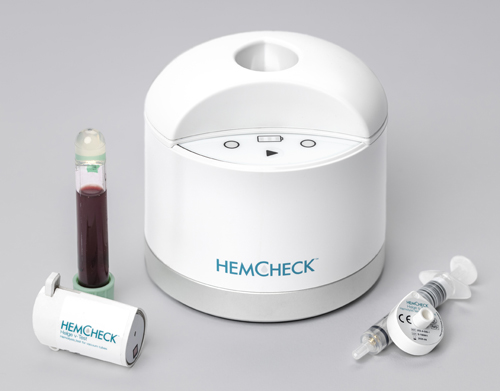New Technology Detects Hemolysis During the Draw
If you're struggling with high hemolysis rates, help may be on the way
A discussion on a new device that detects hemolysis in blood samples as soon as they are drawn.
by Dennis Ernst • March 10, 2021

As you know, I keep my finger on the pulse of the industry so you can focus on what you do best and still stay informed. I just caught wind of a new technology launched in Europe that may be jumping the pond soon. If it meets expectations, it could help solve a problem many have thought unsolvable: hemolysis during a venipuncture.
The device, produced and marketed by HemCheck, detects hemolysis in venous and arterial whole blood samples in vacuum tubes and syringes before you ever leave the patient. If you're filling directly into evacuated tubes, it checks during the draw. Yeah, wow! It got me to sit up and take notice, too.
With HemCheck's patented "v-test" device, if the sample is hemolyzed, you know it immediately and can take corrective measures---i.e., reposition the needle, use low-vacuum tubes, etc.---or simply redraw before leaving the patient. The concept aims to ensures every sample you deliver to the lab is free from hemolysis due to collection technique.
The patented concept uses a portable photometric reader and two testing devices depending on the method of collection; the "v-test" for evacuated tube collections and the "s-test" for syringes with luer connections, including those used for blood gas collections. When filling directly into an evacuated tube, for example, the filled tube is removed from the tube holder and immediately inverted into the v-test device, which filters a minute quantity of blood for direct measurement of the the coloration of the plasma in the reader using only one hand. (See demo here.) With a syringe, the syringe-specific "s-test" is attached after the needle is removed and a minute portion of blood from the syringe is tested in like manner. If hemolysis is detected, a redraw can be conducted immediately. Depending on whether arterial or venous blood is collected the hemolysis test can be done either at the point of collection or in connection with analysis.
Because the reader gives instant, direct feedback on each tube or syringe, recollect rates due to hemolysis can be significantly reduced. That's critical, especially in emergency departments since studies have shown recollections add an hour the the availability of actionable laboratory results, 90-minutes for non-stat draws elsewhere in a healthcare facility.
According to HemCheck, a recent study (publication pending) including 758 blood samples at the the largest emergency unit in Sweden found a 54% decrease of the hemolysis rate when the system was employed. One hundred percent of the participating medical staff were in favor of continuing use of the instant hemolysis test and the concept is now implemented in routine work since the beginning of the year.
With the average frequency of hemolysis in emergency care at 5-12%, costing facilities hundreds of thousands of dollars every year, the v-test can lower hemolysis rate and associated costs with up to 80%. (Hemcheck makes an interactive customized cost/benefit analysis model available.)
For more information: https://hemcheck.com/.
overall rating: my rating: log in to rate
blood draw HemCheck hemolysis hemolyzed preanalytical preexamination syringe tube V-test
7 Comments
Great articl
I enjoyed reading this article. Unfortunately I could not view the demo using the link.
Tanika Taylor, 03/11/2021 16:04:47
link
Sorry about that, Tanika. The links seem to work when tested. Try this one: https://hemcheck.com
Dennis Ernst, 03/11/2021 17:57:20
Affordability & Accessability
Great article! Very interesting, I'm wondering how affordable and accessible this would be to local hospitals and laboratory cooperations?
Concheta, 03/26/2021 08:48:09
Affordability & accessibility
Good question. The concept still needs FDA approval and some clinical studies here in the U.S., so it may be a ways off yet. By then, we should have some data on how affordable and accessible it is in Europe.
Dennis Ernst, 03/26/2021 09:01:11
